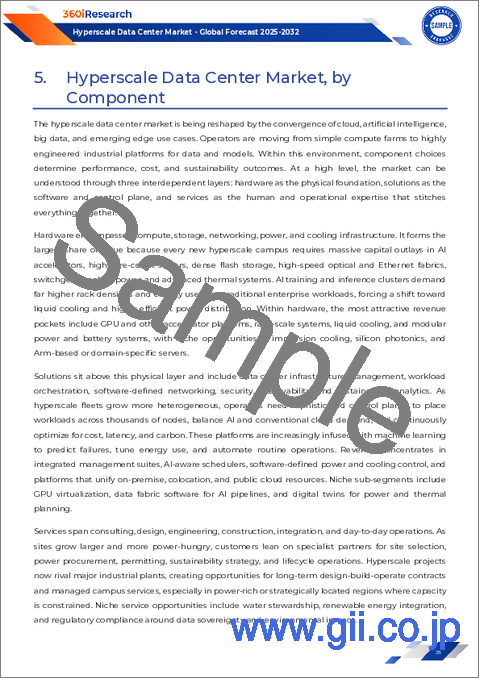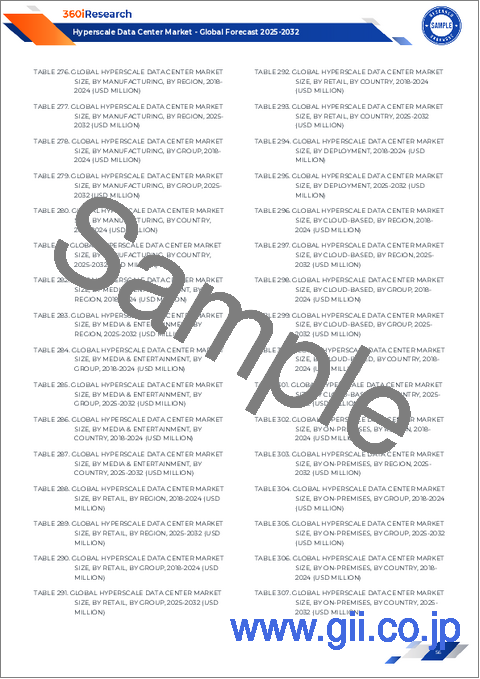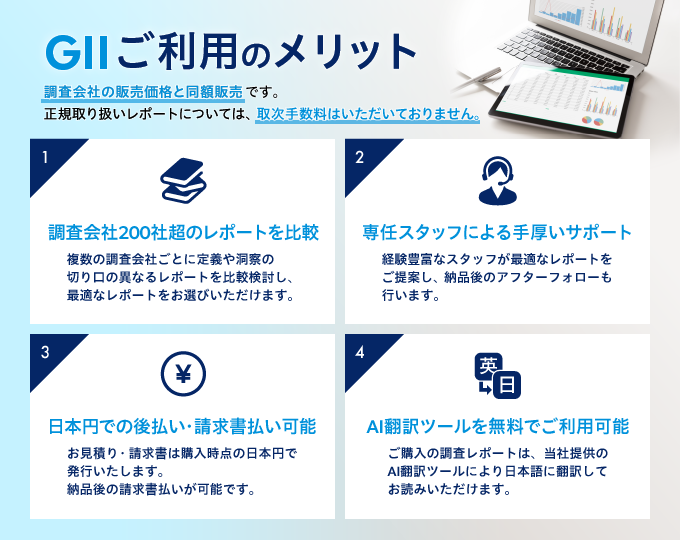|
|
市場調査レポート
商品コード
1829189
ハイパースケールデータセンター市場:コンポーネント、電力容量、冷却ソリューション、データセンター規模、展開、エンドユーザー別 - 2025年~2032年の世界予測Hyperscale Data Center Market by Component, Power Capacity, Cooling Solutions, Data Center Size, Deployment, End-user - Global Forecast 2025-2032 |
||||||
カスタマイズ可能
適宜更新あり
|
|||||||
| ハイパースケールデータセンター市場:コンポーネント、電力容量、冷却ソリューション、データセンター規模、展開、エンドユーザー別 - 2025年~2032年の世界予測 |
|
出版日: 2025年09月30日
発行: 360iResearch
ページ情報: 英文 197 Pages
納期: 即日から翌営業日
|
概要
ハイパースケールデータセンター市場は、2032年までにCAGR 21.58%で2,616億2,000万米ドルの成長が予測されています。
| 主な市場の統計 | |
|---|---|
| 基準年2024 | 547億9,000万米ドル |
| 推定年2025 | 660億1,000万米ドル |
| 予測年2032 | 2,616億2,000万米ドル |
| CAGR(%) | 21.58% |
ハイパースケールデータセンターの戦略的優先事項の基礎となる概要
ハイパースケールデータセンターの状況は、企業やクラウドプロバイダーがこれまで以上の効率性、回復力、スケールを追求する中で急速に進化しています。このイントロダクションでは、設計と運用を再形成する重要な促進要因を統合し、ハイパースケールインフラの意思決定が業界のリーダーにとって戦略的に重要である理由を説明します。サーバーアーキテクチャ、ネットワークファブリック、冷却技術の進歩は、オンデマンドのキャパシティ、高密度のコンピュート、グローバルなフットプリントにわたる堅牢なサービス継続性を求めるビジネスモデルと融合しつつあります。その結果、利害関係者は、資本と運用に関する考慮事項と、導入スケジュールと総所有コストに影響を与える規制、環境、サプライチェーンの力学とのバランスを取らなければならないです。
本セクションでは、サービスやソリューションにおけるコンポーネントの選択、小規模なモジュール型サイトからメガワット以上の施設までの電力容量の計画、従来の空気式システムと新たな液体式アプローチの冷却方法の選択など、変化の主なベクトルを概説することで、本レポートの基礎となるコンテキストを確立します。また、大規模なキャンパス施設から中小規模のデータセンターまで、クラウドネイティブからオンプレミスまで、データセンターの規模や導入モデルがアーキテクチャやベンダー戦略にどのように影響するかについても解説しています。最後に、このイントロダクションでは、銀行、政府機関、ヘルスケア、IT・電気通信、製造、メディア、研究、小売にまたがるエンドユーザーの需要を、パフォーマンス、コンプライアンス、耐障害性の要件を決定づける需要側の力として位置付けています。
ハイパースケールの展開戦略、調達モデル、ベンダーエコシステムを再構築する技術的融合とオペレーションの再設計に関する説得力のある分析
ハイパースケール環境における変革的なシフトは、コンピュートプロビジョニングの場所と方法の再定義を促しており、組織的な対応により、モジュール化、電化、ソフトウェア定義の運用への移行が浮き彫りになっています。エッジ・トゥ・コアアーキテクチャは成熟しつつあり、分散した中小規模の施設と集中化した大規模キャンパスを統合し、キャパシティ割り当てを最適化しながらレイテンシを重視したパフォーマンスを実現する協調的なアプローチを促しています。これと並行して、冷却の技術革新も加速しており、エネルギー効率の向上とラックレベルの熱管理を追求する組織では、液体ベースの冷却が高密度ラックの牽引役となっています。空冷システムは引き続き改良されていますが、液冷への移行は、ラックの設計、保守性、ベンダー選定に直接影響するパラダイムチェンジです。
さらに、ハイパースケール事業者が、エネルギー制約のある地域で100メガワット以上のサイトを展開することの戦略的意味を考慮しながら、1~5メガワットのモジュール設備と5~50メガワットの大規模キャンパスとの間で柔軟な拡張ができるように設計しているため、電力容量の区分も進化しています。分散型アーキテクチャや高速化されたコンピュート・プラットフォームなど、ネットワーキングとサーバーの技術革新は、ソリューション・スタックを再構築し、ライフサイクルと保守のあり方に影響を及ぼしています。その結果、コンサルティング、インストレーション、デプロイメント、メンテナンス、サポート業務がより専門化し、インテグレーターはネットワーク、サーバー、ソフトウェア、ストレージ・ソリューションを包括するエンド・ツー・エンドの能力を提供することが求められるようになっています。このような変化により、より協力的なベンダーエコシステムと、コンポーネントの相互運用性、規制の変化、サービスレベルの期待の進化を見越した戦略的な調達態勢が必要となります。
2025年の貿易政策のシフトが、ハイパースケールプロジェクトの調達ラティス、サプライチェーンの回復力戦略、展開リスクの枠組みをどのように変化させたかを包括的に評価します
2025年の米国における関税賦課は、ハイパースケールデータセンターの計画、調達、サプライチェーンアーキテクチャに顕著な変曲点をもたらしました。関税によるコスト圧力は、多くの事業者に調達戦略の見直しを促し、地域間でのコンポーネント調達の多様化を加速させました。これを受けて、大手インテグレーターや相手先商標製品メーカー数社は、製造フットプリントを最適化し、地域のサプライヤーを優先し、リードタイムの変動を緩和するために在庫バッファリングを拡大した。このような適応はハードウェアに限ったことではなく、サービス契約、配備スケジュール、プロジェクトのライフサイクルにわたって増加した投入コストを分配する契約上のパススルー・メカニズムにまで及びました。
その結果、事業者は、関税賦課とロジスティクスの複雑さを最小限に抑えるため、現地での組み立てと構成能力をより重視するようになりました。同時に、規制環境は総プロジェクトリスクの再評価を促し、資本計画担当者は、関税の持続性、相互措置、貿易協定の変遷を反映したシナリオ分析を取り入れるようになりました。並行して、より高密度のサーバー・プラットフォームへの移行や液冷などの技術選択は、性能上の利点だけでなく、設置面積や出荷量を削減する能力についても評価され、それによって輸入関税の影響を完全に回避することができました。結局のところ、関税情勢は、弾力性のある調達の幅広い再評価を促し、業界参加者にサプライチェーンの再構築、商取引条件の再交渉、地域の部品サプライヤーとのパートナーシップの加速を余儀なくさせました。
コンポーネント、容量、冷却、サイジング、展開、エンドユーザーのパターンを、ハイパースケール展開のためのカスタマイズされた製品・サービス戦略に結びつける、非常に詳細なセグメンテーション分析
セグメンテーションの洞察により、コンポーネント、電力容量、冷却、データセンター規模、展開モデル、エンドユーザーの業種別に、差別化された需要パターンと特化の機会が明らかになります。サービスには、コンサルティング、設置・展開、保守・サポートが含まれ、付加価値の高い統合とライフサイクル保証がますます特徴的になっています。一方、ソリューションには、ネットワーク、サーバー、ソフトウェア、ストレージが含まれ、弾力的なパフォーマンスニーズに対応するため、分解と複合化に向けて再構築が進んでいます。電力容量に基づくと、1~5メガワットのモジュール導入用に設計された施設、5~50メガワットのキャンパス運用用に拡張された施設、100メガワット以上のサイトで遭遇する専門的なエンジニアリング、グリッドへの関与、エネルギー調達の複雑さなど、エンジニアリングアプローチの明確な層別化が見られます。
目次
第1章 序文
第2章 調査手法
第3章 エグゼクティブサマリー
第4章 市場の概要
第5章 市場洞察
- AIと機械学習ワークロードの採用の増加により、高度な処理能力を備えたハイパースケールデータセンターの需要が高まっています。
- クラウドコンピューティングとデジタルトランスフォーメーションの取り組みの急激な成長により、ハイパースケールデータセンターの需要が急増
- ハイパースケールデータセンターのエネルギー効率と運用の持続可能性を向上させるための高度な冷却技術の導入が増加
- ハイパースケールデータセンターに電力を供給し、二酸化炭素排出量を削減するためのグリーンエネルギー源と持続可能な慣行への投資の増加
- ハイパースケールデータセンター内のエッジコンピューティング統合の拡大により、データ処理速度が向上し、レイテンシが短縮されます。
- 強化されたセキュリティプロトコルとAI駆動型脅威検出システムが、重要なデータを保護するためにハイパースケールデータセンターで標準になりつつある
- モジュール式でスケーラブルなインフラストラクチャ設計の採用により、ハイパースケールデータセンターの容量を迅速に拡張し、コストを最適化できます。
- 5Gネットワークの展開と接続をサポートするために、ハイパースケールクラウドプロバイダーと通信事業者間の連携を強化
- ハイパースケールデータセンターの運用効率を向上させるための高度な自動化とAI駆動型管理システムの実装
- 災害復旧とデータ主権コンプライアンスを強化するために、ハイパースケールデータセンターのロケーション多様化戦略への注目が高まっています。
第6章 米国の関税の累積的な影響, 2025
第7章 AIの累積的影響, 2025
第8章 ハイパースケールデータセンター市場:コンポーネント別
- サービス
- コンサルティング
- インストールと展開
- メンテナンスとサポート
- ソリューション
- ネットワーキング
- サーバ
- ソフトウェア
- ストレージ
第9章 ハイパースケールデータセンター市場:電力容量別
- 1~5メガワット
- 5~50メガワット
- 100メガワット以上
第10章 ハイパースケールデータセンター市場:冷却ソリューション
- 空気冷却
- 液体ベースの冷却
第11章 ハイパースケールデータセンター市場:データセンター規模別
- 大規模データセンター
- 中小規模データセンター
第12章 ハイパースケールデータセンター市場:展開別
- クラウドベース
- オンプレミス
第13章 ハイパースケールデータセンター市場:エンドユーザー別
- 銀行、金融サービス、保険(BFSI)
- 政府と防衛
- ヘルスケア
- IT・通信
- 製造業
- メディア&エンターテイメント
- 研究と学術
- 小売り
第14章 ハイパースケールデータセンター市場:地域別
- 南北アメリカ
- 北米
- ラテンアメリカ
- 欧州・中東・アフリカ
- 欧州
- 中東
- アフリカ
- アジア太平洋地域
第15章 ハイパースケールデータセンター市場:グループ別
- ASEAN
- GCC
- EU
- BRICS
- G7
- NATO
第16章 ハイパースケールデータセンター市場:国別
- 米国
- カナダ
- メキシコ
- ブラジル
- 英国
- ドイツ
- フランス
- ロシア
- イタリア
- スペイン
- 中国
- インド
- 日本
- オーストラリア
- 韓国
第17章 競合情勢
- 市場シェア分析, 2024
- FPNVポジショニングマトリックス, 2024
- 競合分析
- 365 Data Centers
- AirTrunk Operating Pty Ltd.
- ALE International SAS
- Amazon Web Services, Inc.
- Arista Networks, Inc.
- Broadcom Inc.
- China Telecom Corporation Limited
- Chindata Group Holdings Limited
- Cisco Systems, Inc.
- CtrlS Datacenters Ltd.
- Dell Technologies Inc.
- Delta Electronics, Inc.
- EdgeConneX Inc.
- Extreme Networks, Inc.
- Google LLC by Alphabet Inc.
- Hewlett Packard Enterprise Development LP
- Huawei Technologies Co., Ltd.
- Intel Corporation
- International Business Machines Corporation
- Iron Mountain Incorporated
- Lenovo Group Ltd.
- LightWave Networks, Inc.
- Marvell Technology Group Ltd.
- Meta Platforms, Inc.
- Microsoft Corporation
- Nlyte Software Ltd.
- NTT Corporation
- NVIDIA Corporation
- TierPoint, LLC





